Using Meteor Scatter
Palle Preben-Hansen, OZ1RH
Meteor scatter basics
Meteor scatter is the reflection of radio waves from the ionised trails from meteors burning up in the upper atmosphere. This may be used by radio amateurs to make QSOs up to about 2,300km. Meteor scatter is described many places in the amateur literature, but just to make sure you know the basics here is an overview.
Meteors burn up in the upper atmosphere at a height of around 105km. The trail will reflect our radio waves best if the trail is orientated as shown in figure 1, which is taken from Meteor Burst Communications The Gap Filler by Daniel E. Warren, http://www.borg.com/~warrend/metburdu.html. You can calculate the probable best beam direction in both azimuth and elevation. Computer programs take care of this, so do not worry. For a start just beam on the great circle bearing.
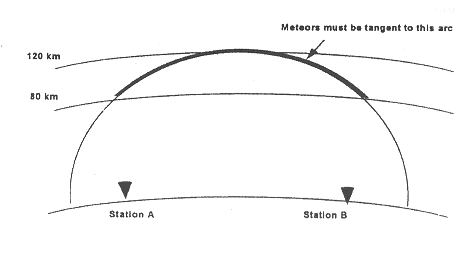 Figure 1: Meteor reflection Geometry
Figure 1: Meteor reflection Geometry
Meteors may come at any time, but sometimes they come in showers which can be predicted. During showers there are more meteors than usual and QSOs are easier to make. Most work on 144 MS is done during showers, where 144.300 may sound like 14 MHz in the bursts. A MS trail reflects 50MHz longer than 144, so it is easier to work MS on 50MHz. Actually you do not need to wait for a MS shower at all to make QSOs on Six.
Meteors on Six sound like brief enhancements of the signal you are listening for. Out of the noise pops your QSO partner at 59+ for mostly less than a second, but then he fades fast away again. Sometimes bursts are many seconds long and you may be lucky to make a QSO in one burst. But as ever on Six you have to be fast..
You should prepare yourself to make the QSO in small bits of mostly a few seconds. There is a procedure for MS-QSOs agreed on in IARU Region 1. If we all follow it, the QSOs are much easier. Here is an extract of the official procedure from http://www.scit.wlv.ac.uk/vhfc/iaru.r1.vhfm.4e/5B.html:
IARU Region 1 meteor scatter procedure
Timing
It is recommended that stations use 2.5 minute periods on telegraphy and 1 minute periods on SSB. This practice gives quite satisfactory results. However, growing technical standards make it possible to use much shorter periods and amateurs may wish to arrange one minute schedules for telegraphy and shorter periods for SSB, especially during major showers. Note: for 50 MHz SSB, 15 second timing may be used, see later in this article.
All MS operators living in the same area should, as far as possible, agree to transmit simultaneously in order to avoid mutual interference.
If possible, northbound and westbound transmissions should be made in periods 1, 3, 5 etc. counting from the full hour. Southbound and eastbound transmissions should be made in periods 2, 4, 6 etc.
When arranging schedules, one or two hours duration for the schedule may be used. Starting times should be on the hour (e.g.0000, 0100, 0200 UT etc.)
QSO procedure for scheduled contacts and random operation
a. Calling
The contact starts with one station calling the other, e.g. "DL7QY SM3BIU DL7QY ....". In telegraphy the letters "de" are not used.
b. Reporting system
The report consists of two numbers:
| 1st | Burst | 2nd | Signal |
| nr | duration | nr | strength |
| 2 | up to 5 sec | 6 | up to S3 |
| 3 | 5 to 20 sec | 7 | S4, S5 |
| 4 | 20 to 120 sec | 8 | S6, S7 |
| 5 | Longer 120 sec | 9 | S8 and stronger |
c. Reporting procedure
A report is sent when the operator has positive evidence of having received the correspondent’s or his own callsign or parts of them.
The report is given as follows: "UA1WW I1BEP 26 26 UA1WW I1BEP 26 26 ....". The report should be sent between each set of callsigns, three times for telegraphy, twice for SSB, and must not be changed during a contact even though signal strength might well justify it.
d. Confirmation procedure
As soon as either operator copies both callsigns and a report he may start sending a confirmation. This means that all letters and figures have been correctly received. Confirmation is given by inserting an R before the report: "SM7FJE G3SEK R26 R26 SM7FJE ...". A station with an R at the end of the callsign could send "GW3ZTH I4BER RR27 RR27 ...".
When either operator receives a confirmation message, such as "R27", and all required information is complete he must confirm with a string of R’s, inserting his own callsign after each eighth R: "RRRRRRRR HG5AIR RRRR ....". When the other operator has received R’s the contact is complete and he may respond in the same manner, usually for three periods.
e. Requirements for a complete QSO
Both operators must have copied both callsigns, the report and a confirmation that the other operator has done the same. This confirmation can either be an "R" preceding the report or a string of "RRRR..."’s as explained in paragraph 7.d.ii.
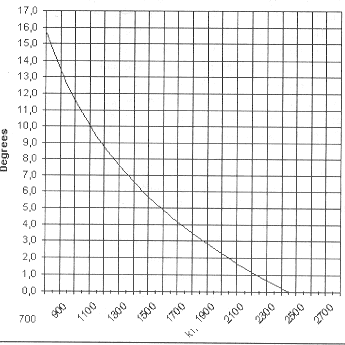 Figure 2: Meteor scatter radiation angles
Figure 2: Meteor scatter radiation angles
Radiation angles
Supposing the MS reflections take place at a height of 110 km, the required radiation angle can be taken from figure 2.
As you can see, angles below 10 degrees will fit a QSO distance of over 1,100 km. The height of your antenna should reflect this. If you are on a hilltop or have a tall tower you could end up with too low angle of radiation for a 700-1,100 km QSO. However the meteors are random and not all are burning at exactly 110 km, so do not take this curve too seriously but try MS out and see how you do.
The easiest range is 1,200-1,500 km so try your first QSOs in this range.
MS on Six
Meteor scatter QSOs can be made fairly easy during showers, however my experience working contests from OZ5W/OZ9EDR shows that 1,200km QSOs can be made any time on Six using random meteors, if you have power and antenna gain. If you have 1kW out you get an instant QSO, with 100W out a sked may be helpful. At OZ5W we once worked a station with 160W at 1,600 km on a dead band, marginal but possible on a winter evening!
I managed to break a pileup of G-stations calling GD4IOM during both UKSMG winter 96/97 contests, when Six was dead. He was working locals on troposcatter at a rate of about one a minute, when I tried to attract attention via MS. In the Lazio contest in April ‘97 I surprised about 15 stations from Italy by working them on a dead band and giving out 27 and 37 reports. All these QSOs were in the easy range of 1,100-1,600 km and using at my end 1kW to 2x6 ele at a height giving the radiation angle for this range.
Shorter range than about 1,100 km is seldom successful, as the beams have a over 10 dB dip in the radiation pattern at radiation angles needed for 800-1,100km. This might be overcome by beaming off the great circle bearing or by having another antenna with maximum radiation where the other has its dip. I have tried a second antenna and it seems to work, though it is quite difficult to compare antennas for MS propagation! Try for yourself ...
GJ4ICD at about 1,130 km always puts a good signal in my RX on MS or even sometimes on what I assume is ionoscatter. No sked needed. The same goes for I5MXX and also IKØBAL at 1,500 km who puts a nice signal in my RX.
Propagation
QSOs on Six up to about700 km can be made any time using troposcatter as described in my earlier articles in ‘Six News’ 49 and 50, check http://www.uksmg.org/tropo.htm or the GJ4ICD CD-ROM. Longer distances may be worked using reflections from meteor trails.
Meteors burn up in the upper atmosphere most frequently at 105-110km and create an ionised trail in the E-layer, which may reflect radio waves for a short moment. This gives ranges like single hop Es of up to about 2,300 km. The best signals are from 1,100 to 1,600 km.
One trail gives communication possibilities from you to an oval footprint on the earth, about 100km wide and some 100km long. For point-to-point communication of secret information (=military) this is an advantage, but not for CQing.
Many people have experience from 144MHz of making QSOs during meteor showers. Everything on how this is done is described in the excellent documentation of OH5IY’s meteor scatter program. He tells you much theory and experience on MS, it is a ‘how to do’ on 144MHz meteor scatter (see the references at the end of this article). I will not copy from this text, but will concentrate on telling you how to take advantage of random meteors for making QSOs on Six.
Going lower in frequency to 50MHz makes it much easier to make MS QSOs and it is no big problem to make QSOs on Six using random meteors. Most commercial use of meteor scatter is taking place at 35-60 MHz, so Six is the best band to experience MS on.
Observations of random meteors show that the reflections come from two ‘hot spots’ about +-10 degrees from the great circle bearing to the other station. Which hot spot is most active is dependent on the path (North-South or East-West) and the time of the day. The different activity of the hot spots is caused by the Earth’s rotation and its movement around the Sun towards or away from the meteors. No reflections come directly from the great circle bearing as the geometry does not fit. Most amateurs beam great circle bearing and get success, because our beamwidth is wide enough to cover both hot spots.
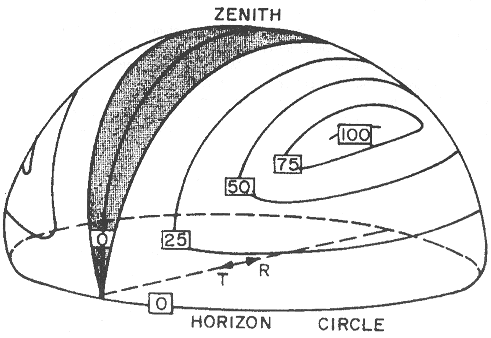 Figure 3: Distribution of useful meteor
radients, displayed by contours on the celestial hemisphere
Figure 3: Distribution of useful meteor
radients, displayed by contours on the celestial hemisphere
The MS ‘hot spots’ move closer and closer to on-path as the distance gets greater, and there is but a single hot spot at path midpoint when you reach the geometric propagation distance limit at about 2,300 km.
These ‘hot spots’ are often mentioned in the literature, but all the sources I have read use the same drawing, which seems to come from: Hines, C.O, Journal of Atmospheric and Terrestrial Physics, 1956, pp.229-232. This drawing (figure 4) shows predicted diurnal variations in random meteor counts for a path length of the order of 1,000 km. The following is for middle latitudes in the northern hemisphere. If you are south of the equator reflections from the north and south side of an east-west path would be interchanged.
For a north-south path the west side is the most productive from 18H to 06H local peaking at 03H. The east side of a north-south path is better from 06H to 18H and peaks at 10-11H. Maximum meteor reflection counts on a north-south path are not at 06H local time!
For an East-West path, the north side is best from 00H to 12H and it peaks at 06H. The south side is best from 12H to 24H, but is on a quite even and low level.
This only applies to random meteors, in fact some assumptions were made in the fifties on the isotropic distribution of meteor velocities in a heliocentric system and a line density of trail ionization which is independent of meteor speed. I have no idea to what extend these assumptions are valid, and I do not care either, as it is possible to make QSOs anyway.
The afternoon and early evening has fewer meteors, but the reflections should be longer as the trails tend to form at lower heights, where the trails persist longer. Longer reflections are no disadvantage to making QSOs, so there is no reason to give up making QSOs in the evening.
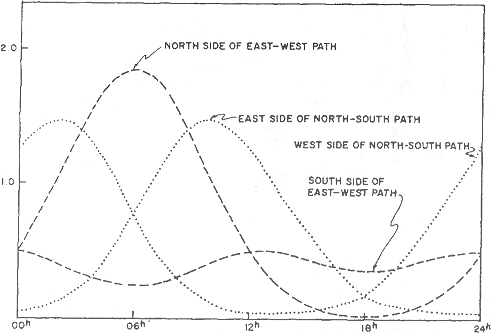 Figure 4: Predicted diurnal variations in random meteor counts
Figure 4: Predicted diurnal variations in random meteor counts
With help from OH5IY I have realized this ‘hot spot’ stuff is only for random meteors, and not valid for showers. Unless your antenna is very narrow this +- perhaps 10 degrees in azimuth is not important. However if you beam off great circle bearing using lower angle of radiation, you had better pick the best side of the path, that is the best ‘hot spot’.
The meteors of a shower seem to come from a circle with a diameter of about ten degrees. So your beam should not be narrower than this. On 144 MHz an H-stack of 4x18-XXX M2 longboomers will be about 13 degrees wide, so we are talking about quite big antennas if it should be too narrow for 144 MHz meteor scatter. On 50 MHz no amateur antenna will be too narrow. A high gain antenna will not give more meteors, but the reflections will be audible for longer. An improvement from S5 to S6 will not matter, only going from S0 to S1 will.
My conclusion is that if you use an EME antenna for meteor scatter it should have a beamwidth of more than 10 degrees. You need to know where to point your beam, and the same applies to your QSO partner. If you both have a sharp EME antenna you should agree on which hot spot to use.
Vertical radiation pattern seems to be more important than azimuth for random meteor QSOs. Elevation control should be considered for the shorter distances, and is well described many places like OH5IY’s fine MS-program with documentation. 1,200km requires about six degrees radiation angle. Radiation angle is not the same as the elevation angle of your antenna. The radiation angle depends on height over reflecting ground and the terrain slope. You need YTAD from the ARRL or K6STI’s Terrain Analyzer to estimate your radiation angle.
The rate of random meteors varies through out the year somewhat as shown in figure 5.
Even during the day the random meteors are unevenly distributed, as shown in figure 6.
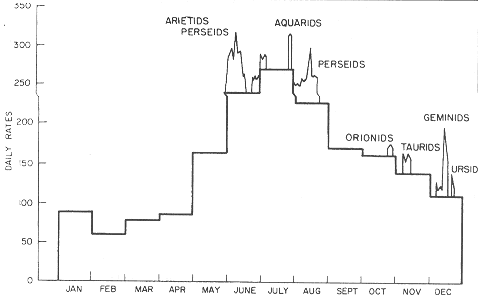 Figure 5: Seasonal variation of meteor rates,
after G.S. Hawkins, 1956, Astron. J. 61,388
Figure 5: Seasonal variation of meteor rates,
after G.S. Hawkins, 1956, Astron. J. 61,388
As you can see MS is not so good during the local afternoon and early evening p, but QSOs are still possible. However it is much easier during the night and morning
The doppler shift on 40MHz MS is around 50Hz so it does not bother us. I have experienced 50MHz MS signals disappearing in the noise with an auroral tone caused by the trail being blown up by strong ionospheric winds.
Do not expect double hop MS, it is rare that two meteors are there at the same time, each with the right geometry to the other. But the stronger propagation modes like Es could be extended with one hop of MS in one of the ends if enough ERP is provided.
A good linear is certainly an advantage. The cosmic noise level on Six is much higher than on the higher VHF bands, so it is important to have some ERP on Six to overcome the noise and be heard. ERP is the key to a dead 50MHz band, so get a linear running. A converted SB-220 can be bought for 850 USD in the states.
The cosmic noise is not evenly distributed on the sky. The difference beaming towards a quiet spot on the sky and a noisy one is about 6dB on Six. So I assume a clean pattern combined with good antenna gain would be nice to have on Six.
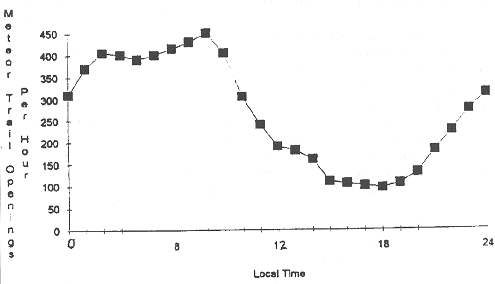 Figure
6: Relative average diurnal meteor rates.
Figure
6: Relative average diurnal meteor rates.
However consider that MS is not an exact science as the meteors arrive only with some statistical probability. So calculating a beamwidth of 9.5 degrees and 5.9 degrees elevation does not guarantee a burst even during half an hour!
So beware: random meteors are random no matter how much you calculate. Statistics may help, but the meteors come when and where they come...
MS procedures for Six
The European MS procedure, described earlier, aims at 144MHz high speed CW, though I have been told it is valid for 50 MHz SSB too.
In my experience the official 1 min sequencing is too long on 50MHz, where there are many more usable bursts than on 144. Also the average 50MHz operator does not know the procedure, so we need some kind of procedure working in this environment.
Thus I have adapted the official MS procedure for 15 second sequencing. This seems to work OK and I can work a station who seems to be unaware of the fact that we are using MS.
MS procedure with 15 seconds sequencing for contest:
Beaming south you transmit 15-29 and 45-59 seconds past the minute. Beaming north you transmit 0-14 and 30-44 seconds past the minute. An accurate clock is needed.
Send complete exchange that is report, QSO number (if needed) and locator as one exchange: ’27 IO91JK‘ or ‘27001 IO91JK Avon’. Remember to use full six-digit locators if required.
After you have received all OK add ‘Roger’ to the send report: ‘R27 JO55UL’. Do never send ‘Roger’ unless you have copied everything.
When you have received all OK and received a Roger send RRRRR for two periods.
This may take long time, we have made QSOs that took 20 min to complete, so do not give up! At OZ5W we keep trying, just notice any power difference. MS outside showers seems to require at least 100W. If you have a kW linear, QSOs will take only few minutes. 10dB antenna gain or more should be there also, and the antenna should be at a height giving a relevant radiation angle (= ground gain) say 7-3 degrees for 1.200 to 1.800 km.
At OZ5W we have this, so the shorter distances are seldom good for us on MS. For the shorter distances we have put up a 5 ele low over ground to get high angle radiation. Another possibility is to beam offset great circle bearing as described in OH5IY’s excellent program.
The transition from troposcatter (or Es) CQ and QSOs to MS procedure is a problem if you use one minute sequencing. Also a one minute RX period means you could lose the QRG, others think nothing is happening. So 15 second sequencing works better, the only problem is accurate clocks and the fact it is difficult to follow the timing during CQs and the QSO.
It sounds easy, but wait until you try. It is quite stressful to call every 15 sec +- 1 sec, try it! I find that 15 sec sequence on random QSOs tends to end up in some kind of panic if the other fellow does not know what is happening (which is the case most of the time).
On the other hand, one minute sequence = no QSO as the other fellow leaves the frequency during your one minute RX period. With the 15 second sequence he might just stay long enough, as something is happening (you TX) frequently. So 15 second sequencing gives QSOs as it also works for QSO partners who do not know the procedure.
If you have a sked one minute sequences could do, at least you know your QSO partner knows the MS procedure. I seldom have skeds, people only know my frequency and call whenever they like.
On 144 MHz high speed CW running 2-4.000 lpm is used. This will be much better for MS on Six than SSB. At OZ5W we have no equipment for high speed CW, but I will get some if enough sked partners 1,000-2,000 km from OZ want to try.
Imagine what could be done on 50 MHz MS if high speed CW or better some other form of digital modulation was used! You could work anything 900-1600km any time very fast. It is done by commercial/military stations and lots of literature is available on how to do it.
Most (all?) commercial use of MS uses some kind of digital communication, ‘high speed CW with time slotting’ is just one simple form of digital communication. The meteor scatter communication possibility was extensively researched around 1954-60 and again in the mid-eighties. First around 1985 was digital communication available cheaply enough and the military saw the possibilities of using MS as a reasonably secure and very reliable communication form. Check NATO’s unclassified AGARD publications.
The OZ5W contest team hopes to work you in the contests. Please check around 50.160 every 4th Tuesday of the month, next time Tuesday February 25
th, March 25th etc. 19-23H local (=18-22 UTC winter and 17-21 UTC summer time). You should hear our kW fairly easy, but if you want us to go to MS procedure (SSB, 15 sec sequencing) let us know you are there by either:A long call with a big linear hoping we hear a burst from you (this is difficult - we need your prefix in order to turn the beam and to use proper sequencing);
A quick call when you hear a burst with our QRZ (difficult, you may have to wait long. It took me 30 min to get GD4IOM this way the first time. The next time he knew how to work a multiplier using MS)
Talk/spot on the Cluster network (only works if your cluster has link to OZ)
Call my GSM: +45 40 71 77 67
Short Internet email to my GSM via SMS: 40717767@note.sonofon.dk . Keep it short and expect no answer, but a QSO!
You could also set up a sked before the test. Contest exchange is report and six-digit locator.
MS is done at frequencies dividable by 5, so pick .130, 135, 140 etc. for your CQ. Please look for us around 50.160. If someone takes this frequency we step down 5 kHz until we find a clear spot.
If your cluster allows it try ‘Talk’ to OZ5W@OZ3DXC or OZ5W@OZ9DXC. We have never been able to talk to DX via the cluster network, as nothing seems to get past the DBØHRO-6 limited protocol, not even if we add your cluster in the Talk-command. If someone knows the cluster sysops please let them fix it. At OZ5W we do not want to use ‘Announce all’ for traffic to just one station.
Our cluster network is seldom linked to LA, SM4-5-0, OH, G and I from OZ. It is difficult to create activity on a dead band, without help from packet. When will the cluster sysops make the network work? Sometimes we do not even have links to SM6 and 7. We need spot and TALK-capability_ for 2,000 km in all directions to arrange difficult and next-to-impossible QSOs. After all, we all want to make a special or difficult QSO stretching the limits of our gear.
One other problem: the relatively weak MS signals are masked by Es, video, splatter... MS is easier when the band is dead, which it may well be in the winter months.
73, Palle, OZ1RH (OZ5W - OZ9EDR contest team)
If you want to discuss troposcatter or make skeds I can be contacted at:
E-MAIL: oz1rh@dialip.csc.dk
Phone: +45 46 78 77 67 GSM during tests: +45 40 71 77 67
OZ5W and OZ9EDR QRV JO55UL/JO64GX major contests and 19-23H local:
1st Tuesday of the month: 144.280+.305 2x8874 2x18elm M2+2/4x9elm
2nd Tuesday of the month: 432.180 3CX800A/4CX400A 4x20elm/2x21elm
3rd Tuesday of the month:1296.180 OZ1BGZ 70 W at 4x37 elm JO65AP
4th Tuesday of the month: 50.160 2x8874 1kW 2x6elm often /P JO55KR
Literature
Beware of texts dealing with visual observation of meteors. There is only a limited correlation between visual meteors and meteors giving reflection of radio waves.
Proceedings of IRE Dec 1957 (the whole issue is on MS!)
NBS Monograph No.80 Ionospheric Radio Propagation, Kenneth Davies, Apr. 1st, 1965
AGARD conference proceedings No. 244, 382 and 419
I suspect the past 40 years of research has come up with something better on radio reflections from random meteor trails. If you have references to other research literature perhaps even on ionoscatter dating newer than 1960 please let me know.
On Internet check out these URLs:
OH5IY’s program is available at http://www.sci.fi/~oh5iy/radio50.zip
(version 5.0)
http://www.scit.wlv.ac.uk/vhfc/iaru.r1.vhfm.4e/5B.html
IARU Region 1 Meteor scatter Operating Procedures
http://www.scit.wlv.ac.uk/vhfc/iaru.r1.vhfm.4e/
IARU Region 1 VHF Manager’s Handbook